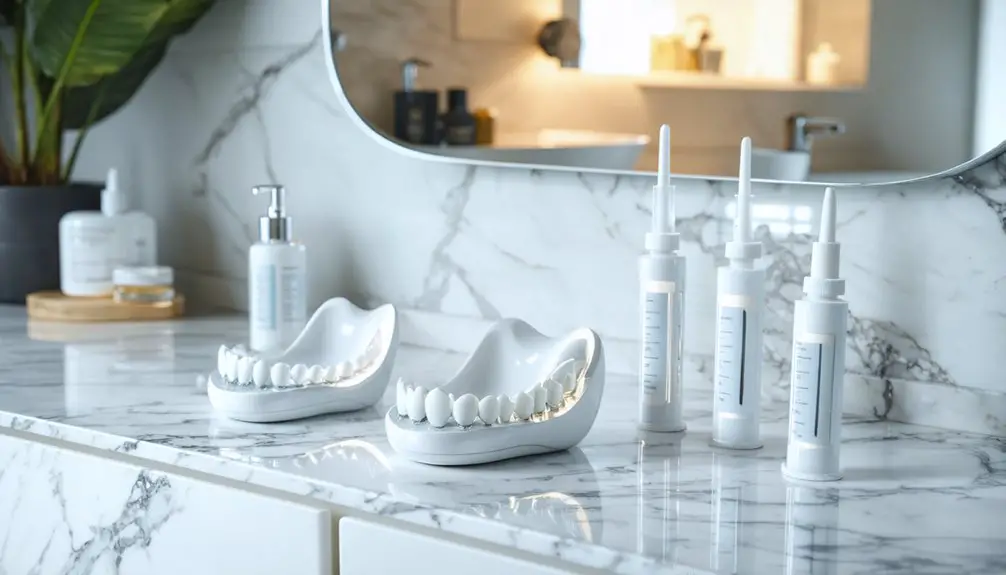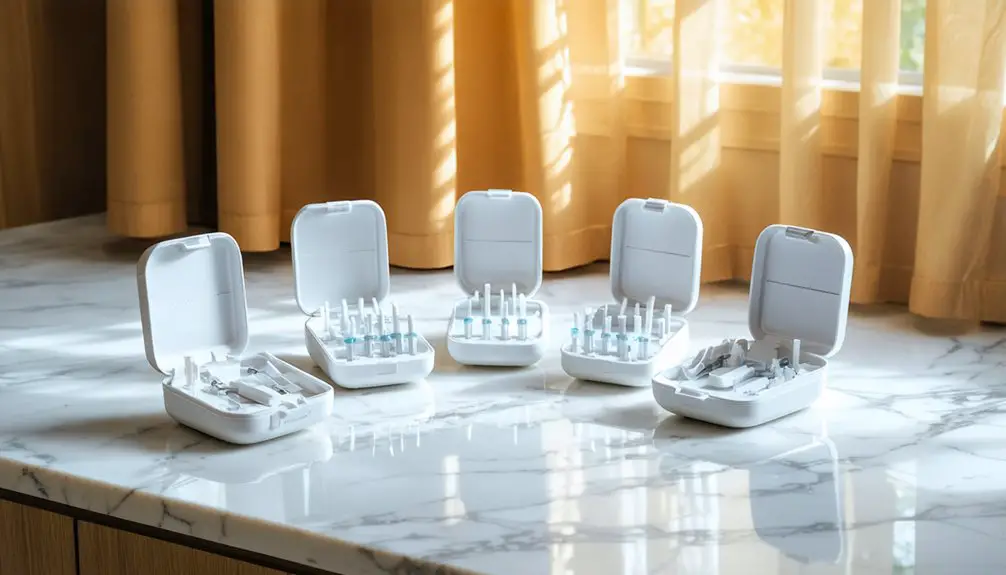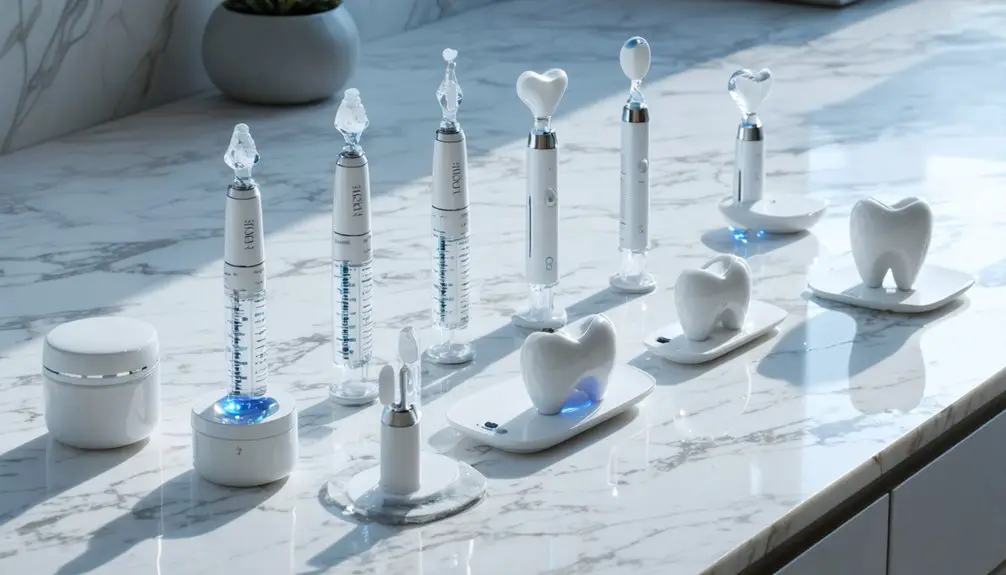You’ll find the most effective home teeth whitening kits combine peroxide-based agents with LED technology for professional-grade results. Top-rated options include the Snow Diamond Wireless Kit, Crest 3DWhitestrips Sensitive + LED, and Auraglow Deluxe Kit, which can improve tooth color by up to 10 shades within weeks. While entry-level kits start at $60, premium systems reaching $300 offer faster results and better sensitivity management. Understanding the science behind these systems will help you choose the best solution.
Key Takeaways
- Snow Diamond Wireless Kit leads the market in 2025, offering full shade improvement in one session using advanced dual-light technology.
- Crest 3DWhitestrips Sensitive + LED combines gentle whitening agents with LED technology for effective results without excessive sensitivity.
- Auraglow Deluxe Kit delivers impressive results with up to 10 shade improvements within a week of regular use.
- LED-activated whitening kits provide faster results than traditional strips, with visible changes possible in just 20 minutes.
- At-home whitening kits range from $5-$300, with mid-range LED systems offering the best balance of effectiveness and value.
Understanding How Teeth Whitening Works
To understand how teeth whitening works, you’ll need to first grasp the basic structure of teeth and how staining occurs. Your teeth consist of three layers: the outer enamel, yellowish dentin beneath, and inner pulp containing nerves.
Contrary to common whitening myths, stains primarily affect your enamel’s porous surface. Professional whitening methods often deliver faster whitening results than home treatments. Regular dental cleanings help prevent stubborn external stains from forming.
When you apply whitening agents like hydrogen peroxide or carbamide peroxide, they penetrate the enamel and break down stain molecules through oxidation. These agents create free radicals that dismantle complex stain compounds, resulting in a brighter appearance.
While concerns about enamel health are common, proper use of whitening products typically causes only temporary softening without significant mineral loss. The key is choosing appropriate concentrations and following application guidelines to protect your tooth structure while achieving desired results.
Top-Rated Home Whitening Products for 2025
The home teeth whitening market has evolved considerably in 2025, offering innovative solutions that combine effectiveness with user convenience.
Modern teeth whitening brings professional-grade results home, revolutionizing how we achieve brighter smiles in 2025.
Among the top rated kits, the Snow Diamond Wireless Kit stands out with its rapid whitening capability, delivering a full shade improvement in just one session. The system’s innovative dual-light technology combines blue LEDs for enhanced whitening with red light for gum health.
User reviews consistently praise the Crest 3DWhitestrips Sensitive + LED for its gentle yet effective approach, while the Auraglow Deluxe Kit garners attention for achieving up to 10 shade improvements within a week. Regular users report achieving three shades lighter in just two weeks with consistent use.
For those seeking natural alternatives, Lumineux Strips provide peroxide-free whitening through essential oils.
Budget-conscious consumers will find value in Zimba Whitening Strips, which deliver noticeable results at a lower price point, achieving a 2.7 shade improvement over two weeks of use.
Active Ingredients That Power Whitening Results
You’ll find hydrogen peroxide and carbamide peroxide as the primary active ingredients in most effective home whitening kits, with concentrations ranging from 3% to 15% depending on the formulation.
LED technology can enhance these peroxides’ whitening action by accelerating the oxidation process that breaks down stain molecules embedded in your tooth enamel.
While natural alternatives like activated charcoal and baking soda exist, they lack the standardized efficacy and predictable results of peroxide-based systems.
Professional dental cleaning before starting a whitening regimen can provide more optimal results.
For optimal safety and effectiveness, the FDA has set maximum limits of 15% carbamide peroxide for over-the-counter whitening products.
Primary Whitening Agents Explained
Understanding primary whitening agents requires familiarity with two key chemical compounds: hydrogen peroxide and carbamide peroxide. These agents work through oxidation to break down stains on and within your teeth.
Hydrogen peroxide delivers faster results at higher concentrations (up to 35% in professional treatments), while carbamide peroxide offers gentler, sustained whitening effects. Safe teeth whitening products should contain proven active ingredients for optimal results. Tooth-colored restorations and artificial materials will not respond to whitening agents.
For home use, you’ll find carbamide peroxide concentrations up to 15% (equivalent to 5.4% hydrogen peroxide) and hydrogen peroxide levels between 3-6%.
When comparing peroxides, consider that higher concentrations accelerate whitening but increase sensitivity risks. For ideal whitening safety, follow FDA guidelines and avoid prolonged exposure.
Carbamide peroxide is particularly effective in tray-based systems, providing controlled release while minimizing tissue irritation.
LED Technology Benefits
Modern LED technology has revolutionized home teeth whitening by accelerating the chemical reactions that break down stubborn stains. When combined with peroxide-based whitening agents, LED light activates the oxidation process more effectively, helping you achieve noticeable results in as little as 20 minutes. Products like DiamondSeries feature Hydroxyapatite and Potassium to maximize whitening while protecting enamel health. Many patients achieve 6-8 shades lighter teeth in a single whitening session.
The LED advantages are significant compared to older UV technology. You’ll benefit from safer treatment without harmful cell mutations or heat damage to your enamel and soft tissues.
The uniform light distribution guarantees even whitening across your teeth, while the cooling effect minimizes sensitivity. LED’s whitening efficiency stems from its ability to enhance peroxide gel effectiveness without requiring higher concentrations of active ingredients.
You’ll appreciate the user-friendly nature of LED devices – they’re energy-efficient, portable, and require no warm-up time for peak performance.
Natural Ingredient Options
While LED technology enhances whitening effectiveness through light activation, natural ingredients offer alternative pathways to brighter teeth.
Hydrogen peroxide safety remains paramount, as this natural bleaching agent effectively oxidizes stains when properly diluted.
While activated charcoal benefits include quick surface stain removal, its abrasive nature warrants cautious use to prevent enamel damage.
Baking soda efficacy proves comparable to commercial whitening toothpaste, especially when combined with hydrogen peroxide.
Despite turmeric‘s limitations in actual whitening, its anti-inflammatory properties support overall oral health.
You’ll find additional whitening support through natural diets rich in crunchy vegetables and dairy products. These foods mechanically clean teeth while strengthening enamel against stains.
For best results, combine gentle natural ingredients with proper dental hygiene practices.
LED Technology vs. Traditional Methods
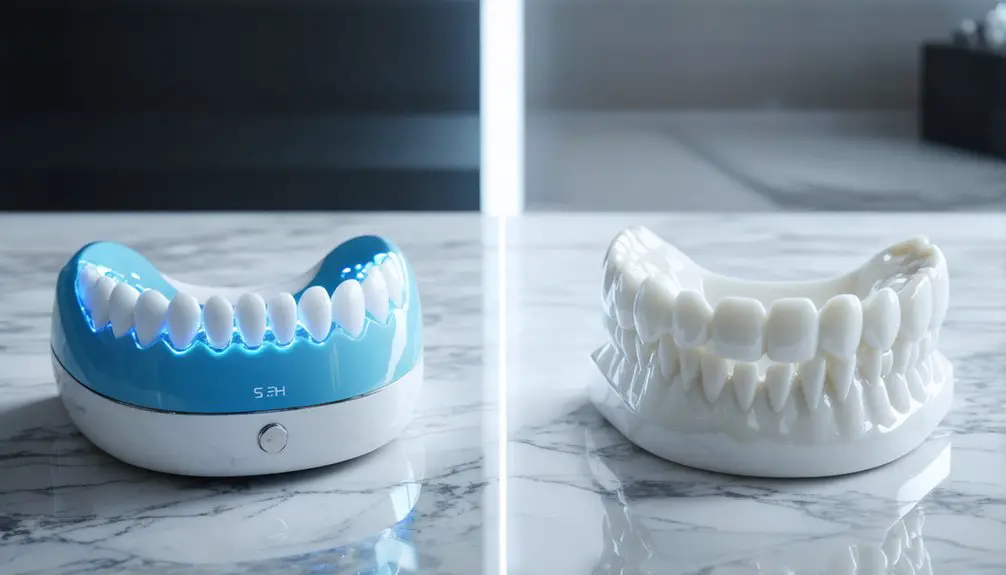
While traditional whitening methods like strips and toothpaste require weeks of consistent application, LED technology accelerates the whitening process by activating peroxide gels through targeted light exposure.
You’ll notice LED treatments can achieve up to 8 shades of improvement in a single 20-60 minute session, compared to the gradual results from conventional methods.
LED’s precision targeting allows deeper penetration into both enamel and dentin layers, offering more thorough whitening than surface-level traditional treatments.
Light Acceleration Benefits
Although traditional teeth whitening methods rely solely on peroxide-based gels, LED light technology has emerged as a catalyst that can accelerate the bleaching process through enhanced photochemical reactions.
When combined with hydrogen peroxide or carbamide peroxide gels, LED activation notably improves whitening effectiveness, achieving color changes of up to 5.2 units on the dental shade scale.
You’ll find that light activation speeds up peroxide breakdown, creating more reactive oxygen species that tackle stubborn stains faster.
This enhanced peroxide interaction can reduce your treatment duration while maintaining comparable safety profiles.
However, it’s essential to monitor sensitivity management, as higher peroxide concentrations, not the LED light itself, typically cause temporary tooth sensitivity.
The data shows that LED technology works best as a complementary tool to peroxide-based whitening rather than as a standalone treatment.
Traditional Methods Comparison
Since LED technology has revolutionized teeth whitening treatments, it’s crucial to understand how it compares to traditional methods across key performance metrics.
A comparison analysis reveals that LED whitening greatly outperforms traditional methods in several areas. While strips and whitening toothpaste require weeks or months of consistent use, LED treatments can lighten your teeth by multiple shades in a single 30-60 minute session.
You’ll experience less sensitivity with LED technology compared to traditional methods, which often cause prolonged discomfort and gum irritation. LED treatments also penetrate deeper into the enamel, providing more uniform and longer-lasting results than surface-level traditional approaches.
Though traditional methods offer greater accessibility and lower costs, they can’t match LED technology’s superior whitening power and precision in achieving your desired results.
Safety Considerations and Potential Risks
Before undertaking any teeth whitening treatment, you must understand the potential risks and safety considerations associated with home whitening kits. Product reliability varies greatly, with unregulated kits potentially containing harmful concentrations of bleaching agents that can damage your enamel and irritate soft tissue.
Be cautious with home whitening kits – unregulated products may contain dangerous bleaching levels that can harm tooth enamel and gum tissue.
A dental consultation is essential to evaluate your oral health and determine if you’re a suitable candidate for whitening.
You’ll need to exercise particular caution if you have dental restorations, untreated cavities, or gum disease. Poorly fitting trays can cause uneven results and increase gum irritation.
While trusted brands offer safer formulations with proper guidelines, excessive use of any whitening product can lead to permanent sensitivity and weakened enamel.
Always choose products from reputable manufacturers and follow instructions precisely to protect your oral health.
Managing Tooth Sensitivity During Treatment
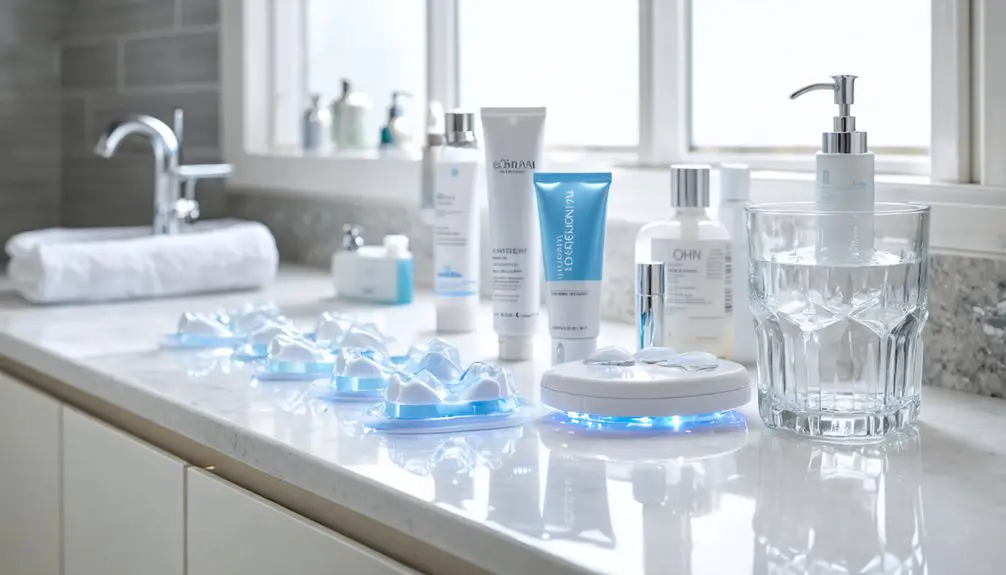
To minimize tooth sensitivity during whitening, you’ll want to select products containing built-in desensitizing agents like potassium nitrate or fluoride, while ensuring your chosen concentration matches your teeth’s sensitivity level.
Before starting treatment, strengthen your enamel by using sensitivity toothpaste for two weeks and consider discussing pre-treatment fluoride options with your dentist.
If sensitivity occurs during whitening, you can obtain immediate relief by applying desensitizing gel, reducing treatment frequency, or temporarily pausing treatment while continuing to use sensitivity toothpaste.
Choosing Sensitivity-Safe Products
For those with sensitive teeth, selecting an appropriate whitening kit requires careful consideration of peroxide concentrations and desensitizing agents.
Focus your product selection on formulations containing 6% to 10% peroxide, as these lower concentrations minimize tooth nerve irritation while still providing effective whitening results.
Look specifically for kits labeled for sensitive teeth, which typically include built-in desensitizing ingredients to block nerve signals.
You’ll want to complement your whitening treatment with a desensitizing toothpaste containing potassium nitrate, starting 1-2 weeks before beginning the process.
For ideal sensitivity management, choose products that include protective gels or treatments you can apply before whitening sessions.
Remember that professional guidance from your dentist can help guarantee you’re selecting products that balance whitening efficacy with proper sensitivity protection.
Prevention Before Treatment Starts
When preparing for teeth whitening treatment, a thorough preventive approach greatly reduces sensitivity risks and optimizes results.
Start by scheduling a dental health assessment to identify and address any underlying issues like cavities or gum disease that could interfere with treatment success.
You’ll need to make dietary adjustments in the weeks before whitening. Avoid acidic foods and beverages while increasing calcium-rich options to strengthen your enamel.
Switch to a soft-bristled toothbrush and gentle brushing technique to protect your teeth and gums. Apply professional-grade desensitizing gels as directed to block pain signals and create a protective barrier.
If you’re using at-home treatments, carefully follow the recommended schedule without overexposure to bleaching agents.
These preventive steps will considerably minimize discomfort and enhance your whitening outcomes.
Quick Relief Methods
Despite the effectiveness of teeth whitening treatments, temporary sensitivity is a common side effect that requires prompt management.
You’ll find immediate relief by applying desensitizing gels containing potassium nitrate or fluoride directly to affected areas. These products quickly calm irritated nerve endings exposed during the whitening process.
For longer-lasting protection, ask your dentist about fluoride varnish treatments, which can provide up to 8 weeks of sensitivity reduction.
You can also switch to toothpaste formulated specifically for sensitive teeth, containing stannous fluoride or potassium nitrate. These ingredients effectively block pain signals while promoting enamel remineralization.
When sensitivity occurs, promptly using these desensitizing agents will help control discomfort and allow you to continue your whitening regimen with minimal interruption.
Cost Analysis of Popular Whitening Systems
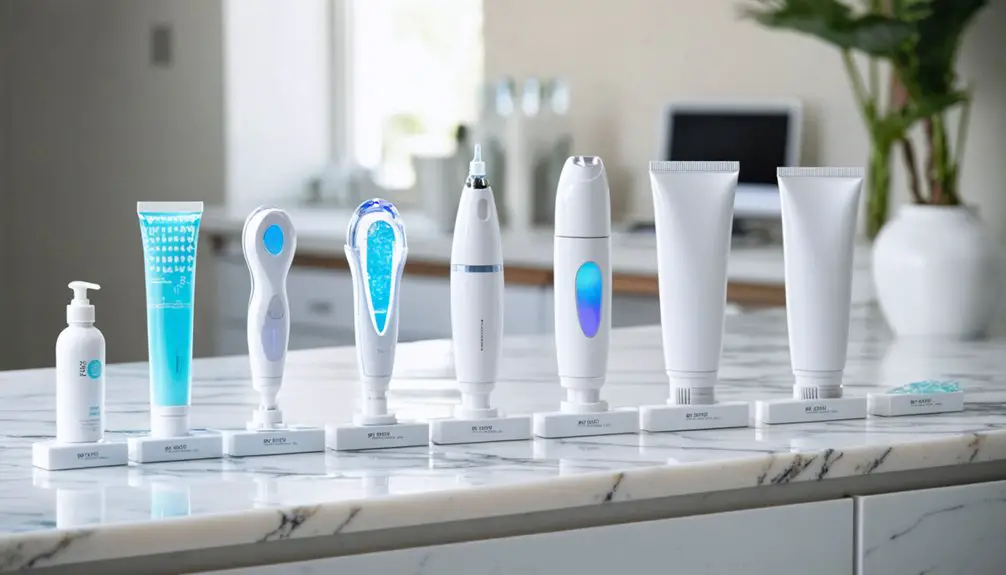
Understanding the cost landscape of teeth whitening systems reveals significant price variations across different product categories.
You’ll find entry-level options like whitening toothpaste at $9, while extensive at-home kits with LED technology can reach $300. A product comparison shows professional treatments cost $400-$1,000, making at-home solutions more cost-effective for most budgets.
- Over-the-counter kits ($5-$60) offer gradual results with moderate peroxide concentrations, ideal for mild staining.
- Mid-range systems ($50-$300) include advanced features like LED activation, delivering faster results in 3-7 days.
- Professional treatments, while expensive, provide immediate results and may prove more economical for those requiring dramatic whitening.
Choose based on your whitening goals, timeline requirements, and financial considerations, as higher investments typically correlate with faster, more dramatic results.
Time Investment and Expected Results
The time commitment required for teeth whitening varies considerably across different treatment options, directly impacting the speed and quality of results you’ll achieve.
At-home kits typically require 20-60 minutes per daily session over 1-2 weeks, while professional in-office treatments deliver faster results in a single 90-minute appointment.
Your results timeline depends on the method you choose. Professional laser treatments can brighten teeth by 6-8 shades immediately, while at-home kits gradually achieve 2-6 shades of improvement.
Most people notice initial changes within 3-7 days using at-home systems. For ideal longevity, you’ll need to plan for maintenance sessions every 4-6 months, though results can last up to 3 years with professional treatments and proper oral care habits.
Natural vs. Chemical Whitening Options
When choosing between natural and chemical teeth whitening methods, you’ll find significant differences in their mechanisms of action and effectiveness.
Chemical whitening agents containing hydrogen peroxide or carbamide peroxide penetrate deeper into teeth, delivering more dramatic results than natural alternatives. While natural options like activated charcoal and baking soda can remove surface stains, their whitening efficacy doesn’t match professional chemical treatments.
Professional chemical whitening penetrates tooth structure for superior results, while natural methods only address superficial stains on the enamel surface.
- Professional chemical whiteners combine bleaching agents with fluoride for enhanced enamel protection and consistent results.
- Natural methods like oil pulling and strawberry treatments offer gentle but limited whitening with minimal risk of sensitivity.
- Chemical treatments under dental supervision provide controlled, predictable outcomes while minimizing potential damage to teeth and gums.
Tips for Maximum Whitening Success
To achieve ideal results from home teeth whitening kits, successful implementation depends on proper preparation, consistent application, and diligent aftercare protocols.
Begin by consulting your dentist to assess tooth health and determine best whitening frequency. When applying gel, verify custom-fitted trays are properly loaded to maximize contact while minimizing gum exposure. You’ll need to maintain strict adherence to manufacturer instructions regarding application timing to prevent enamel damage.
During treatment, avoid staining substances like coffee, tea, and red wine. Apply protective barriers to sensitive areas before each session. Monitor for any tooth sensitivity and adjust frequency accordingly.
For maintenance, continue thorough oral hygiene practices and schedule regular dental check-ups to evaluate results. Remember that noticeable changes require patience – expect gradual improvement over several weeks of consistent use.
Frequently Asked Questions
Can I Whiten My Teeth While Wearing Braces?
You shouldn’t whiten teeth during traditional braces treatment due to uneven results and teeth sensitivity risks. Instead, maintain proper braces care and wait until after removal for professional whitening treatment.
Does Smoking After Whitening Affect the Results?
While you’ll achieve initial brightness, smoking effects will rapidly reverse your whitening results. Your teeth’s increased porosity post-treatment makes them highly susceptible to nicotine stains, considerably reducing whitening duration.
How Long Should I Wait Between Whitening Treatments?
You should wait 24-48 hours between whitening treatments to prevent teeth sensitivity. If you experience discomfort, extend intervals to 1-2 weeks. Monitor your whitening frequency according to product instructions.
Can Pregnant Women Safely Use Teeth Whitening Products?
You shouldn’t use teeth whitening products during pregnancy due to safety concerns for fetal development. Instead, consider alternative methods like professional cleanings until after delivery and nursing are complete.
Will Whitening Work on Teeth Stained by Medications or Antibiotics?
You’ll find limited effectiveness with whitening on medication stains since they’re intrinsic. Professional treatments may partially lighten some discoloration, but you’ll likely need veneers or crowns for significant improvement.
References
- https://www.advancedsmilesmarion.com/resources/best-online-teeth-whitening-kits
- https://www.goodhousekeeping.com/health-products/g28723133/best-at-home-teeth-whitening-products/
- https://g-p-dental.com/best-teeth-whitening-kits-in-2025-safe-option/
- https://heartofthecitydental.com/how-teeth-whitening-works/
- https://sandlakedental.com/blog/understanding-the-science-behind-teeth-whitening/
- https://pmc.ncbi.nlm.nih.gov/articles/PMC6784469/
- https://pmc.ncbi.nlm.nih.gov/articles/PMC4058574/
- https://health.clevelandclinic.org/is-teeth-whitening-safe
- https://gloscience.com
- https://drgeorges.com/dental-white/teeth-whitening-system-comparisons/
